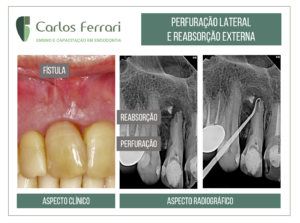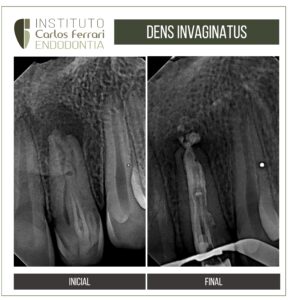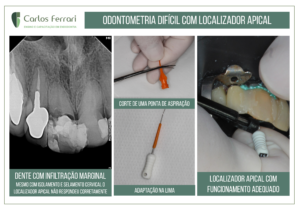Retentor intrarradicular. Remoção de pino de fibra em paciente com abscesso agudo.
Paciente chegou à clínica queixando-se de dor e inchaço na região inferior esquerda. No exame clínico, edema na região gengival apical de prés inferiores esquerdos e presença de retentor. No exame radiográfico, presença de retentor de fibra e tratamento endodôntico insatisfatório no dente 34, bem como presença de imagem radiolúcida periapical difusa no referido dente.
Procedeu-se então o desgaste no retentor a partir do seu centro com ponta diamantada até a guta-percha e em seguida a desobturação com broca de Gates e limas rotatórias.
Caso conduzido pela aluna Bruna Regiani, da especialização em endodontia da APCD Bragança Paulista.
Machado, Ricardo. Endodontia: Princípios Biológicos e Técnicos. Disponível em: Grupo GEN, Grupo GEN, 2022:
Remoção de retentores ou pinos intrarradiculares
Retentores ou pinos intrarradiculares são normalmente indicados para a reabilitação de dentes acometidos por significativa perda de estrutura coronária. Sua utilização deve ser precedida pela realização do tratamento endodôntico, embora o contrário seja inexplicavelmente observado. Não há justificativa para a cimentação de retentores intrarradiculares em canais não tratados endodonticamente.
Após a cimentação de um pino intracanal, o retratamento endodôntico só pode ser realizado mediante a sua remoção. As dificuldades para a execução desse procedimento dependem, principalmente, das características do retentor.
Os retentores intrarradiculares são classificados em fundidos e pré-fabricados. Os primeiros são confeccionados a partir da fundição de uma liga metálica e, até em virtude desse processo, normalmente apresentam boa adaptação às paredes do canal radicular. Já os pinos intrarradiculares pré-fabricados podem ser metálicos e não metálicos. Os metálicos são fabricados em aço inoxidável ou titânio e, segundo a sua forma geométrica, são classificados em cilíndricos ou cônicos. Quanto ao acabamento superficial, dividem-se em lisos, serrilhados e rosqueados. Os pinos não metálicos são fabricados em fibra de carbono, resina epóxica, cerâmica (dióxido de zircônio e óxido de ítrio) ou fibras de vidro embebidas em matriz resinosa com carga.
Retentores intrarradiculares podem ser removidos por tração, desgaste, vibração ultrassônica ou pela associação dessas técnicas, de acordo com o seu tipo. O grau de dificuldade do procedimento depende, principalmente, de suas características morfológicas, de sua adaptação às paredes do canal e do processo de cimentação. Pinos curtos, cônicos e lisos são mais facilmente removidos do que os compridos, cilíndricos e serrilhados.
Retentores intrarradiculares metálicos fundidos
O emprego de métodos de tração para a remoção de pinos metálicos fundidos deve ser muito bem avaliado, pois a aplicação de forças trativas excêntricas pode causar trincas e fraturas radiculares. Estes retentores também podem ser desgastados, preferencialmente com pontas diamantadas esféricas ou brocas carbide em alta rotação, a despeito do risco eminente de fragilização e perfuração radicular. Mesmo com o emprego do microscópio operatório, a visualização do campo de trabalho é prejudicada em razão do tamanho da caneta e do comprimento das brocas.
A vibração ultrassônica é o método mais seguro e efetivo para a remoção de retentores metálicos intrarradiculares fundidos. A energia transmitida promove a degradação do cimento e o deslocamento do pino. O uso simultâneo de dois aparelhos de ultrassom tem sido preconizado para potencializar a intensidade da vibração e diminuir o tempo clínico necessário para a realização do procedimento.
Independentemente da técnica, a remoção de retentores intrarradiculares deve ser adequadamente planejada e executada com o objetivo de evitar erros e acidentes. Abbott, em 2002,44 removeu pinos de 1.600 dentes e somente uma fratura radicular foi observada. Garrido et al., (2009) 45 avaliaram os impactos do diâmetro e do comprimento do núcleo, e do movimento aplicado ao inserto ultrassônico sobre a facilidade de remoção de retentores intrarradiculares. Os resultados do estudo demonstraram que quando o diâmetro do núcleo era similar ao da porção intracanal, a facilidade de remoção foi sensivelmente maior do que quando os núcleos eram mais calibrosos do que o pino em 47% dos espécimes. Quando o diâmetro e a altura dos núcleos eram menores que os dos pinos, a força necessária para a remoção da peça protética foi reduzida em até 70%.
Pinos cimentados com fosfato de zinco são mais facilmente removidos em comparação com os fixados com cimentos resinosos, os quais atenuam as vibrações e absorvem a energia ultrassônica.46,47 A vibração ultrassônica de pinos fixados com cimentos à base de ionômero de vidro e fosfato de zinco deve ser refrigerada, pois facilita o deslocamento. No caso de cimentos resinosos, a ausência de refrigeração interfere na adesão e favorece a descimentação. Entretanto, o aumento da temperatura pode lesar o periodonto. O ultrassom pode ser utilizado por 1 minuto em potência máxima sob refrigeração – período descrito em estudos anteriores como eficaz para reduzir a força de tração necessária para a remoção do retentor e prevenir o excessivo aquecimento da superfície radicular.
O posicionamento da ponta do inserto também pode influenciar no tempo dispendido e na força necessária para o deslocamento do retentor. A vibração ultrassônica, quando aplicada com a ponta posicionada na região cervical do núcleo, favorece a remoção. Além disso, quando realizada de maneira alternada em todas as suas faces, demonstra ser mais efetiva que quando aplicada em uma única superfície, uma vez que a vibração alternada reduz a fricção entre a ponta ultrassônica e o metal, minimizando a liberação de calor, sem perder eficiência.
Vários insertos ultrassônicos podem ser utilizados para a remoção de retentores intrarradiculares, dependendo da marca do equipamento utilizado pelo profissional. Os mais empregados são:
•Insertos com pontas rombas e calibrosas especificamente desenvolvidos para a remoção de retentores, utilizados em potência máxima (90 a 100%)
•Insertos de Periodontia com pontas mais delgadas, empregados em potência média (50 a 80%) .
•Insertos de Endodontia com pontas mais estreitas e finas, diamantadas ou lisas, de diversos tamanhos e calibres, utilizados em baixa potência (10 a 40%) para promover a fragmentação do cimento.
Após o desgaste do núcleo, aplica-se a vibração ultrassônica em suas diferentes faces por meio do uso de um inserto de ponta romba. Em alguns casos, pontas periodontais podem ser utilizadas por apresentarem menores dimensões. A vibração ultrassônica deve ser aplicada na porção mais cervical do núcleo e com refrigeração para evitar o superaquecimento do pino e da superfície radicular, o que pode lesar o periodonto.
https://www.youtube.com/watch?v=QNxKwMPwuEc
https://ferrariendodontia.com.br/retentores-intrarradiculares-2/





